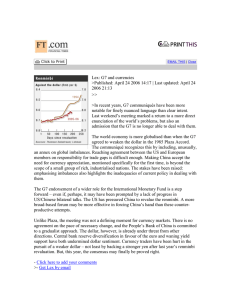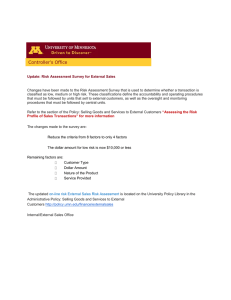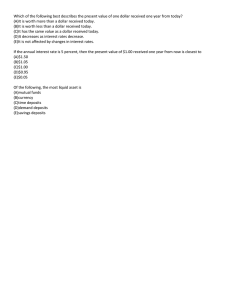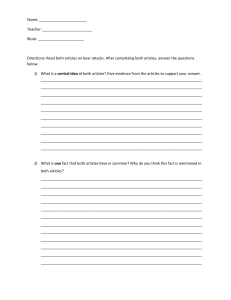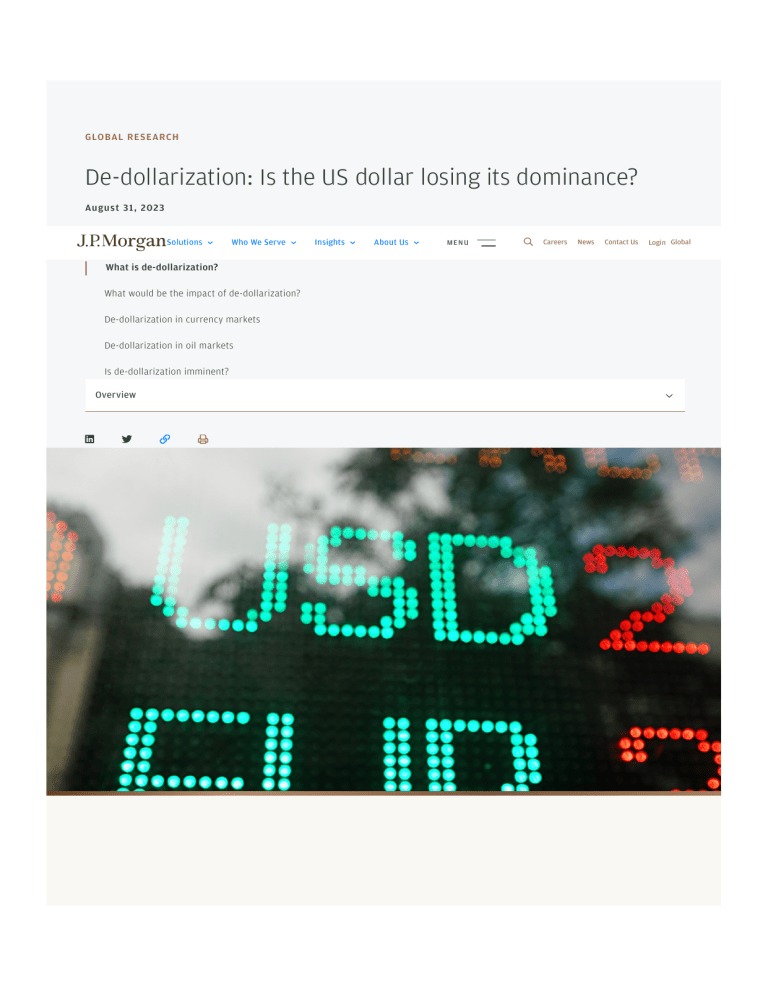
GLOBAL RESEARCH De-dollarization: Is the US dollar losing its dominance? August 31, 2023 Top dollar no more? Find out if the current geopolitical climate is threatening the dominance of the world’s reserve currency. Solutions Who We Serve Insights About Us MENU Careers News Contact Us Login Global What is de-dollarization? What would be the impact of de-dollarization? De-dollarization in currency markets De-dollarization in oil markets Is de-dollarization imminent? What Overview is de-dollarization? Key takeaways The U.S. dollar’s hegemony is in question due to geopolitical and geostrategic shifts, including the ongoing Russia-Ukraine crisis. While the dollar has maintained its transactional dominance, some de-dollarization is taking place in FX reserves. The greenback is also losing some influence in oil markets, where more sales are now being transacted in non-dollar currencies. However, rapid de-dollarization is not on the cards, especially as the U.S. has a long-standing global network of alliances and partnerships. The U.S. dollar is the world’s primary reserve currency, and it is also the most widely used currency for trade and other international transactions. However, its hegemony is in question, especially in light of the ongoing Russia-Ukraine crisis. “The risk of de-dollarization, which is a periodically recurrent theme throughout post-war history, has returned into focus due to geopolitical and geostrategic shifts,” said Alexander Wise, who covers Strategic Research at J.P. Morgan. In particular, the U.S. sanctions on Russia have made some countries wary about being too dependent on the greenback. In addition, against a backdrop of rising interest rates, a strong U.S. dollar is becoming more expensive for emerging nations, leading some to trade in other currencies. In July 2023, Bolivia became the latest South American country — after Brazil and Argentina — to pay for imports and exports using the Chinese renminbi. What are the potential implications of de-dollarization, and what could this mean for global markets and trade? "The risk of de-dollarization, which is a periodically recurrent theme throughout post-war history, has returned into focus due to geopolitical and geostrategic shifts." Alexander Wise Strategic Research, J.P. Morgan What is de-dollarization? In short, de-dollarization entails a significant reduction in the use of dollars in world trade and financial transactions, decreasing national, institutional and corporate demand for the greenback. This would diminish the dominance of the dollar-denominated global capital market, in which borrowers and lenders around the world transact in dollars. There are two scenarios that could erode the dollar’s status. The first includes adverse events that undermine the perceived safety and There are two scenarios that could erode the dollar’s status. The first includes adverse events that undermine the perceived safety and stability of the greenback — and the U.S.’s overall standing as the world’s leading economic, political and military power. For instance, increased polarization in the U.S. could jeopardize the perceived stability of its governance, which underpins its role as a global safe haven. The second factor involves positive developments outside the U.S. that boost the credibility of alternative currencies — economic and political reforms in China, for example. “A candidate reserve currency must be perceived as safe and stable, and must provide a source of liquidity that is sufficient to meet growing global demand,” Wise noted. What would be the impact of de-dollarization? Fundamentally, de-dollarization would shift the balance of power among countries, and this could in turn reshape the global economy and markets. The impact would be most acutely felt in the U.S., where de-dollarization would likely lead to a broad depreciation and underperformance of U.S. financial assets versus the rest of the world. “For U.S. equities, outright and relative returns would be negatively impacted by divestment or reallocation away from U.S. markets and a severe loss in confidence. There would also likely be upward pressure on real yields due to the partial divestment of U.S. fixed income by investors, or the diversification or reduction of international reserve allocations,” Wise said. However, the effect of de-dollarization on U.S. growth is uncertain. While a structurally depressed dollar could raise U.S. competitiveness, it could also directly lower foreign investment in the U.S. economy. In addition, a weakening dollar could in principle create inflationary pressure in the U.S. by raising the cost of imported goods and services, though benchmark estimates suggest these effects may be relatively small. “The dollar’s transactional dominance remains top-of-class despite secular declines in U.S. trade shares. On the other hand, de-dollarization is evident in FX reserves, where the dollar’s share has declined to a record low of 58%.” Meera Chandan Co-Head of Global FX Strategy, J.P. Morgan De-dollarization in currency markets De-dollarization could reduce institutional, investor and corporate demand for the dollar over time, and in size could cause its value to fall. If there is a specific catalyst for the move, de-dollarization could also result in heightened exchange rate volatility, especially as over 60 currencies are pegged to the greenback. However, while some signs of de-dollarization are emerging in currency markets, the dollar is thus far still maintaining its dominance. “Overall dollar usage has declined, but it remains within long-run ranges and its share remains elevated compared to other currencies,” said Meera Chandan, Co-Head of the Global FX Strategy research team at J.P. Morgan. Looking at FX volumes, the dollar’s share stands at 88%, near record highs, while its share of trade invoicing, cross-border liabilities and foreign currency debt issuance has held steady over the last two decades. “The dollar’s transactional dominance remains top-of-class despite secular declines in U.S. trade shares. On the other hand, de-dollarization is evident in FX reserves, where the dollar’s share has declined to a record low of 58%,” Chandan noted. Which currencies could dethrone the greenback? “In terms of competitors, China has been attempting to internationalize the renminbi. However, the renminbi’s global footprint is still small despite growing every year, and this will be a long process requiring reform,” Chandan said. For instance, the renminbi makes up just 2.3% of SWIFT payments, versus the dollar’s share of 43% and the euro’s share of 32%. “With China’s growing centrality in global commerce, one might naturally expect the renminbi to assume a greater role in the global economy over time, but this transition would likely occur over the course of decades,” Wise added. “Relaxing capital controls, opening markets, implementing measures to promote market liquidity, bolstering the rule of law, reducing appropriation and regulatory risk, and promoting Chinese government bonds as an alternative safe asset — these could all cement China and the renminbi as a credible alternative to the U.S. and the dollar.” The dollar’s contrasting fortunes USD’s share of global FX volumes** and global exports (%) VIEW TEXT VERSION De-dollarization in oil markets Some signs of de-dollarization are also playing out in oil markets. “The U.S. dollar, one of the key drivers of global oil prices, appears to be Some signs of de-dollarization are also playing out in oil markets. “The U.S. dollar, one of the key drivers of global oil prices, appears to be losing its once powerful influence,” said Natasha Kaneva, Head of Global Commodities Strategy at J.P. Morgan. Traditionally, the dollar is negatively correlated to oil prices. When the dollar appreciates, the imported price of oil rises and demand falls as a result, especially in emerging market (EM) economies. However, more oil sales are now being transacted in non-dollar currencies such as the renminbi. “Crucially, Russian oil is now either sold in the local currencies of the buyers or in the currencies of countries that Russia perceives as friendly,” Kaneva said. For example, some Indian refiners have begun paying for Russian oil purchased via Dubai-based traders in dirhams, while others are considering doing so in yuan. Saudi Arabia is reportedly exploring the acceptance of payments in other currencies. In addition, major Russian commodity producers have started issuing bonds in yuan. In September 2022, state-owned oil company Rosneft made a public offering of 10 billion yuan in bonds, followed by a second tranche of 15 billion yuan in March 2023. Is the dollar’s dominance truly waning in oil markets? Data from J.P. Morgan Research shows that between 2005 and 2013, a 1% appreciation of the U.S. trade-weighted dollar (USNEER) reduced the price of Brent crude by about 3%. Between 2014 and 2022 however, this figure declined to a mere 0.2%, with OECD oil inventories now playing a much more dominant role in determining oil prices. “Overall, we find that the importance of the dollar has declined significantly from 2014 to 2022,” said Jahangir Aziz, Head of Emerging Market Economics Research at J.P. Morgan. “While it is possible that this shift is overly influenced by the rise in macroeconomic volatility caused by the spike in post-pandemic inflation and geopolitics, it is hard to ignore it altogether." Is de-dollarization imminent? Overall, while marginal de-dollarization is expected, rapid de-dollarization is not on the cards. “This is especially given the considerable advantages that accrue to a ubiquitous currency, and the fact that the U.S. has a long-standing global network of alliances and partnerships,” Wise said. Instead, partial de-dollarization — in which the renminbi assumes some of the current functions of the dollar among non-aligned countries and China’s trading partners — is more plausible, especially against a backdrop of strategic competition. This could over time give rise to regionalism, creating distinct economic and financial spheres of influence in which different currencies and markets assume central roles. Related insights INSIGHTS Global Research J.P. Morgan’s Research team leverages cutting-edge technologies and innovative tools to bring clients industry-leading analysis and investment advice. Learn more This communication is provided for information purposes only. Please read J.P. Morgan research reports related to its contents for more information, including important disclosures. JPMorgan Chase & Co. or its affiliates and/or subsidiaries (collectively, J.P. Morgan) normally make a market and trade as principal in securities, other financial products and other asset classes that may be discussed in this communication.This communication has been prepared based upon information, including market prices, data and other information, from sources believed to be reliable, but J.P. Morgan does not warrant its completeness or accuracy except with respect to any disclosures relative to J.P. Morgan and/or its affiliates and an analyst's involvement with any company (or security, other financial product or other asset class) that may be the subject of this communication. Any opinions and estimates constitute our judgment as of the date of this material and are subject to change without notice. Past performance is not indicative of future results. This communication is not intended as an offer or solicitation for the purchase or sale of any financial instrument. J.P. Morgan Research does not provide individually tailored investment advice. Any opinions and recommendations herein do not take into account individual client circumstances, objectives, or needs and are not intended as recommendations of particular securities, financial instruments or strategies to particular clients. You must make your own independent decisions regarding any securities, financial instruments or strategies mentioned or related to the information herein. Periodic updates may be provided on companies, issuers or industries based on specific developments or announcements, market conditions or any other publicly available information. However, J.P. Morgan may be restricted from updating information contained in this communication for regulatory or other reasons. Clients should contact analysts and execute transactions through a J.P. Morgan subsidiary or affiliate in their home jurisdiction unless governing law permits otherwise.This communication may not be redistributed or retransmitted, in whole or in part, or in any form or manner, without the express written consent of J.P. Morgan. Any unauthorized use or disclosure is prohibited. Receipt and review of this information constitutes your agreement not to redistribute or retransmit the contents and information contained in this communication without first obtaining express permission from an authorized officer of J.P. Morgan. SOLUTIONS CAREERS JPMORGAN CHASE SITES Asset Management Experienced Professionals Chase Commercial Banking Students JPMorgan Chase & Co. Credit and Financing J.P. Morgan Partner Network HELPFUL LINKS Investment Banking Markets About Us CONNECT WITH US Payments Apps Alumni Network Prime Services Events and Conferences Client Login Private Banking Impact Contact Us Securities Services Industries Wealth Management Insights Investor Relations Media Center News and Announcements Newsletters Privacy | Terms of Use Regulatory Disclosures | Accessibility | Cookies Policy | © 2023 JPMorgan Chase & Co. All rights reserved.
